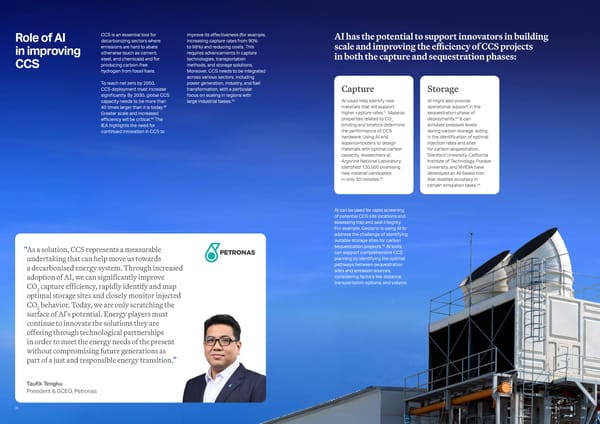Taufik Tengku President & GCEO, Petronas “ As a solution, CCS represents a measurable undertaking that can help move us towards a decarbonised energy system. Through increased adoption of AI, we can significantly improve CO2 capture efficiency, rapidly identify and map optimal storage sites and closely monitor injected CO2 behavior. Today, we are only scratching the surface of AI's potential. Energy players must continue to innovate the solutions they are offering through technological partnerships in order to meet the energy needs of the present without compromising future generations as part of a just and responsible energy transition.” Role of AI in improving CCS AI has the potential to support innovators in building scale and improving the efficiency of CCS projects in both the capture and sequestration phases: CCS is an essential tool for decarbonizing sectors where emissions are hard to abate otherwise (such as cement, steel, and chemicals) and for producing carbon-free hydrogen from fossil fuels. To reach net zero by 2050, CCS deployment must increase significantly. By 2030, global CCS capacity needs to be more than 40 times larger than it is today.48 Greater scale and increased efficiency will be critical.49 The IEA highlights the need for continued innovation in CCS to improve its effectiveness (for example, increasing capture rates from 90% to 98%) and reducing costs. This requires advancements in capture technologies, transportation methods, and storage solutions. Moreover, CCS needs to be integrated across various sectors, including power generation, industry, and fuel transformation, with a particular focus on scaling in regions with large industrial bases.50 Storage AI might also provide operational support in the sequestration phase of deployments.53 It can simulate pressure levels during carbon storage, aiding in the identification of optimal injection rates and sites for carbon sequestration. Stanford University, California Institute of Technology, Purdue University, and NVIDIA have developed an AI-based tool that doubles accuracy in certain simulation tasks.54 Capture AI could help identify new materials that will support higher capture rates.51 Material properties related to CO2 binding and kinetics determine the performance of CCS hardware. Using AI and supercomputers to design materials with optimal carbon capacity, researchers at Argonne National Laboratory identified 120,000 promising new material candidates in only 30 minutes.52 AI can be used for rapid screening of potential CCS site locations and assessing trap and seal integrity. For example, Geoteric is using AI to address the challenge of identifying suitable storage sites for carbon sequestration projects.55 AI tools can support comprehensive CCS planning by identifying the optimal pathways between sequestration sites and emission sources, considering factors like distance, transportation options, and volume. 34 Powering Possible 33
 Powering Possible 2024: AI and Energy for a Sustainable Future Page 17 Page 19
Powering Possible 2024: AI and Energy for a Sustainable Future Page 17 Page 19